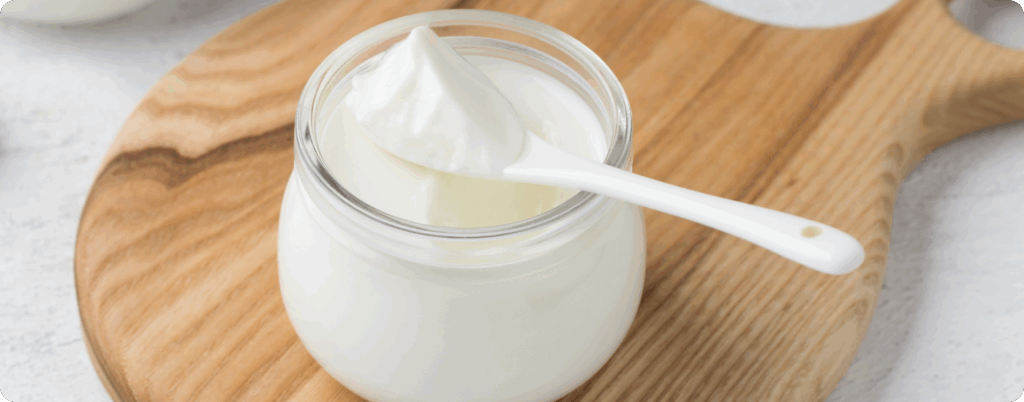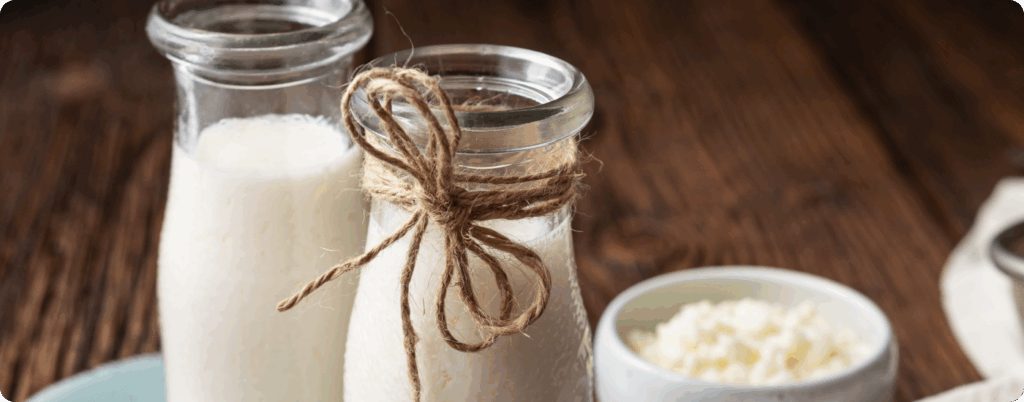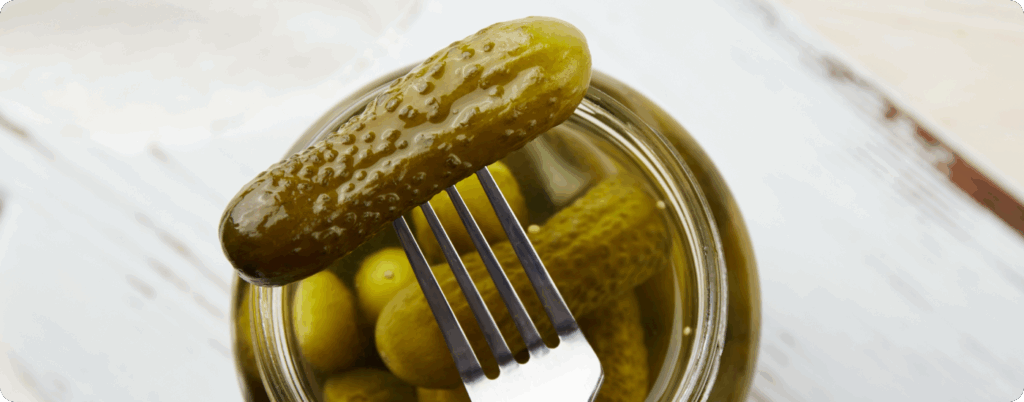PLEASE NOTE: The information in this blog is for educational purposes only. It is not a substitute for professional medical advice. Consult your healthcare provider if you’re seeking medical advice, diagnoses, or treatment.
In the early 1900s, Russian scientist Élie Metchnikoff noticed that Bulgarian villagers lived unusually long lives. He traced it back to one surprising habit: eating fermented dairy!
Over a century later, we now know that probiotic foods can support digestion, mood, immunity, skin, metabolism, and more (1).
In this post, you’ll learn what probiotics are, 6 key health benefits, and the 4 best probiotic foods to include in your diet for long-term wellness.
What Are Probiotics?
Probiotics are live bacteria and yeasts that offer health benefits when consumed in adequate amounts. There are thousands of probiotic strains, with some of the most common being Lactobacillus, Bifidobacterium, and Saccharomyces. These microbes are naturally found in the gut and in many fermented foods.
Probiotics: A Timeless Tradition
Humans have relied on fermented foods for thousands of years. Sour milk drinks are thought to have been the first products purposefully made from milk. Many ancient cultures, such as the Sumerians and Babylonians, practiced milk fermentation (2).
In the 1800s, scientists identified microbes responsible for fermentation, and Russian researcher Élie Metchnikoff famously linked fermented dairy to longevity. The term “probiotic” was coined in 1953, and modern science continues to uncover their powerful health benefits (3).

6 Benefits of Probiotic Foods
1. Digestive Health
Probiotic foods help balance the gut microbiome, supporting digestion, reducing gas, bloating, and improving conditions like IBS or IBD. One study showed that adding fermented foods to the diet increased microbiome diversity and lowered inflammation (4)
2. Immune System Strength
A large portion of our immune system operates in the gut. Probiotics enhance gut barrier integrity, help avoid “leaky gut,” reduce overactive immune responses, and improve resistance to pathogenic microbes (5).
3. Mood & Brain Support
The connection between the gut and brain is powerful! Studies show that some probiotic combinations can reduce depressive symptoms and fatigue and improve sleep (6). When gut inflammation is low, neurotransmitters like serotonin can function more effectively, supporting overall mood.
4. Healthier Skin
Skin conditions like acne, eczema, or rosacea often originate in the gut. Probiotics help by reducing systemic inflammation, improving hydration, supporting skin cell turnover, and balancing skin surface bacteria. (7).
5. Cardiovascular Function
Gut imbalance has been linked to heart failure, high blood pressure, and other cardiovascular issues. Probiotics help restore healthy gut bacteria, reduce inflammation, and inhibit harmful microbes that may contribute to disease. Some probiotic strains have been shown to lower C-reactive protein (CRP), a key marker of inflammation associated with heart disease (8).
6. Weight & Metabolic Health
Specific strains belonging to the genus Lactobacillus and Bifidobacterium have shown positive results for reduced BMI and waist circumference compared to placebo groups after 6 months (9). Probiotics can support insulin sensitivity, crucial for weight management and metabolic health (10).
Supplements vs Probiotic Foods
While probiotic supplements can be convenient, whole foods are often the more powerful, ancestral option. Fermented foods not only contain live bacteria but also enzymes and nutrients that work synergistically to support gut health (11).
A common myth is that the healthy living bacteria in probiotic foods don’t survive digestion, but research tells a different story. For example, studies show that strains like L. delbrueckii subsp. bulgaricus from yogurt can be recovered from stool samples just days after consumption, showing they do reach the gut alive and active (12, 13).

The 4 Best Probiotic Foods
These whole-food probiotic sources are our top picks for delivering both powerful live cultures and nutrient-dense support for digestion, immunity, and energy.
Yogurt
Yogurt contains beneficial strains like L. bulgaricus and S. thermophilus, which can help support gut health, reduce inflammation, and even influence body composition. It is also rich in calcium, protein, and enzymes that make dairy easier to digest (14).
What to look for: Opt for full-fat, unsweetened, grass-fed, or raw milk yogurt with “live and active cultures” on the label. Greek yogurt can be beneficial too, but it has slightly fewer strains than traditional versions.
How to use it: Serve it with honey and berries, use it in smoothies, or mix it with protein powder for extra fuel.
Kefir
Kefir is a fermented milk drink packed with dozens of probiotic strains, making it one of the most diverse and powerful sources available. It also offers calcium, amino acids, healthy fats, and bioavailable protein (15).
What to look for: When possible, choose full-fat, grass-fed, or raw milk kefir. Store-bought versions are fine, but be cautious of added sugars and flavorings. Homemade kefir gives you the best control over ingredients and potency.
How to use it: Drink it on its own, mix it into smoothies, or blend with raw milk, maple syrup, or fruit for a gut-friendly breakfast or snack.
Sauerkraut
Raw sauerkraut is fermented cabbage teeming with lactic acid bacteria, enzymes, and digestive-supportive acids. It’s also a great source of fiber, vitamin C, and sulfur-containing compounds that benefit detox pathways.
What to look for: Buy only unpasteurized sauerkraut stored in the refrigerated section. Pasteurized versions don’t contain live cultures. Avoid ones with vinegar added.
How to use it: Add a scoop to your burger, steak, or sausage. It adds a tangy crunch and digestive support with zero prep.
Pickles
Traditional fermented pickles are cucumbers soaked in a saltwater brine that becomes rich in probiotics over time. They’re flavorful, crunchy, and offer digestive benefits similar to sauerkraut (16).
What to look for: Choose pickles that say “fermented,” “raw,” or “contains live cultures.” Avoid vinegar-brined or shelf-stable versions, which don’t contain probiotics.
How to use it: Snack on them straight, add to charcuterie boards, or top your burgers or steaks for an added immune boost with a salty crunch.

What About Kimchi & Kombucha?
Kimchi: Kimchi often contains spicy peppers and other plants with strong defense chemicals that can irritate the guts of sensitive individuals.
Kombucha: Kombucha contains yeast and bacteria, often refreshing and microbiome‑friendly, but many commercial kombuchas are high in sugar. Check the labels for low-sugar options with organic ingredients, and drink sparingly.
What about Histamines in Probiotic Foods?
If you have histamine sensitivity, some fermented foods can trigger symptoms. If this applies to you, it’s best to introduce probiotic foods slowly and monitor your response. To learn more, check out our blog post: Animal-Based & Histamine Intolerance: What You Need to Know.
Tips for Gut Health
Probiotic foods are powerful but just one piece of the puzzle. Here are a few key ways to holistically support your gastrointestinal health.
- Eat nutrient-dense animal foods: Essential nutrients found in organ meats and muscle meats like zinc and certain amino acids can support and nourish the the gut lining. Our Gut & Digestion supplement is a great option.
- Limit irritating plant foods: Some plant compounds (like lectins and oxalates) found in vegetables, legumes, and grains can be troublesome for many (17). Focus on ripe fruits, which are easier to digest.
- Prioritize quality sleep: Poor sleep can impair gut function and microbial balance (18). Aim for 7+ hours of consistent, restful sleep each night.
- Manage stress: Chronic stress affects digestion, weakens the gut barrier, and alters microbiome diversity (19). Incorporate daily stress-relief practices like walking, meditation, or deep breathing.
Probiotic Foods: The Bottom Line
Probiotic foods are a crucial part of a gut-friendly diet. They support healing, immune balance, cardiovascular health, mood, skin, and energy. Rather than trying all at once, pick one source you’ll enjoy and can access, and add it daily or several times per week. Notice the difference in the way you feel.
Subscribe to future articles like this: